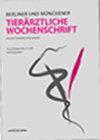Course of plasma substance P concentrations during umbilical surgery in calves
IF 0.6
4区 农林科学
Q4 VETERINARY SCIENCES
Berliner und Munchener tierarztliche Wochenschrift
Pub Date : 2018-01-01
DOI:10.2376/0005-9366-17103
引用次数: 10
Abstract
The objective of this orientating study was to describe plasma concentrations of substance P in calves undergoing umbilical surgery with two different analgesic protocols. The study was conducted as a randomized controlled double blinded trial. Ten calves (aged 39 10 days) were treated with meloxicam (CON) for analgesia, and 11 calves (aged 37 8 days) with meloxicam and metamizole (MET). Umbilical surgery under general anaesthesia was performed according to a strictly standardized protocol. Blood samples were taken at the day of surgery (one hour before and 5, 15, 30, 45, 60, 90, 150 and 510 minutes after skin incision). Plasma concentrations and AUC of substance P were determined. Plasma substance P increased during umbilical surgery in both groups. In CON, there was a significant difference to plasma substance P baseline concentration 5, 30 and 90 minutes after skin incision. Plasma substance P concentrations were lower in MET compared with CON at all times, and did not differ significantly from baseline concentration. Even though there was no significant difference in the plasma substance P concentrations in-between the groups, the results show that after the administration of metamizole additionally to meloxicam, plasma substance P concentrations in MET were lower than in CON at all times. This fact could indicate that substance P might be a suitable biomarker for nociception and pain. Further studies are needed to confirm this hypothesis.犊牛脐部手术过程中血浆P物质浓度的变化
本定向研究的目的是描述两种不同镇痛方案下接受脐部手术的小牛血浆P物质浓度。本研究采用随机对照双盲试验。10头犊牛(39 10日龄)使用美洛昔康(CON)镇痛,11头犊牛(37 8日龄)使用美洛昔康和metamizole (MET)镇痛。全麻下的脐部手术按照严格的标准化方案进行。于手术当日(手术前1小时及皮肤切开后5、15、30、45、60、90、150、510分钟)采血。测定血浆P物质浓度和AUC。两组患者血浆P物质均在脐部手术期间升高。CON患者在皮肤切开后5、30、90分钟血浆P物质基线浓度差异有统计学意义。与对照组相比,MET组血浆P物质浓度始终较低,与基线浓度无显著差异。尽管两组之间血浆P物质浓度没有显著差异,但结果显示,在美洛昔康加用安咪唑后,MET组血浆P物质浓度始终低于CON组。这一事实可能表明P物质可能是一种合适的疼痛和伤害感觉的生物标志物。需要进一步的研究来证实这一假设。
本文章由计算机程序翻译,如有差异,请以英文原文为准。
求助全文
约1分钟内获得全文
求助全文
来源期刊
CiteScore
0.90
自引率
0.00%
发文量
0
审稿时长
18-36 weeks
期刊介绍:
The Berliner und Münchener Tierärztliche Wochenschrift is an open access, peer-reviewed journal that publishes contributions on all aspects of veterinary public health and its related subjects, such as epidemiology, bacteriology, virology, pathology, immunology, parasitology, and mycology. The journal publishes original research papers, review articles, case studies and short communications on farm animals, companion animals, equines, wild animals and laboratory animals. In addition, the editors regularly commission special issues on topics of major importance. The journal’s articles are published either in German or English and always include an abstract in the other language.

 求助内容:
求助内容: 应助结果提醒方式:
应助结果提醒方式:


